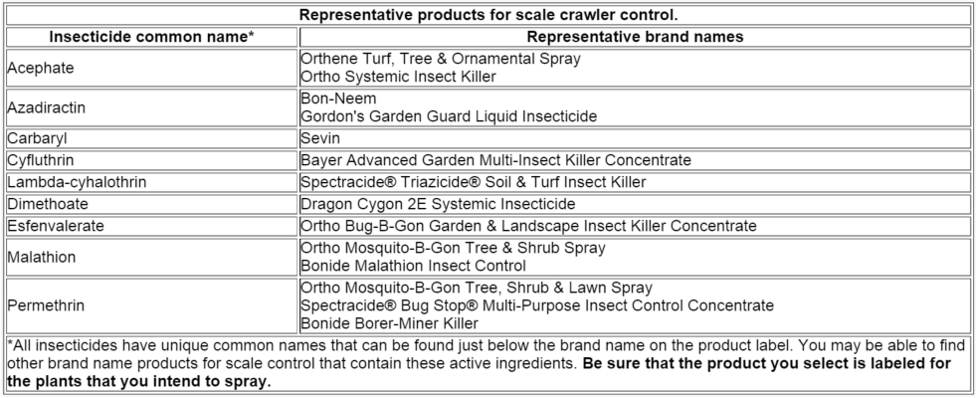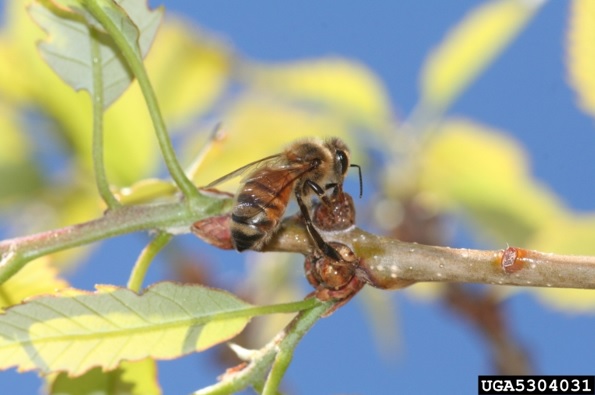Lecanium Scales
ENTFACT-430: Lecanium Scales | Download PDF
by By Jonathan L. Larson, Extension Entomologist and Lee Townsend, Extension Specialist Emeritus
University of Kentucky College of Agriculture
Lecanium Scale Fast Facts
- The term “lecanium scale” refers to a group of scale insect pests that are soft scale pests of multiple trees and ornamental species.
- In general, these scale insects are semi-globular brown scales that can be 1/8 inch to 1/6 inch wide.
- As soft scales, they can create obnoxious amounts of sticky honeydew which can recruit other insects and black sooty mold to grow on the plant; they may also cause leaf drop and twig dieback.
- Management can depend on crawler control using contact insecticides or organic options like horticultural oil or insecticidal soap or can rely on systemic treatments of imidacloprid or dinotefuran in the fall.
Figure 1: This redbud has been infested by European fruit lecanium, one of the common lecanium pest species. Lecanium scales are a soft scale species with globular, brown bodies. (Photo by Jim Kalisch, University of Nebraska-Lincoln)
Potential Hosts
Lecanium scales can feed on a wide swath of important trees and ornamental plants. Oak, hickory, birch, and fruit trees are commonly infested by these pests.
Symptoms and Pest Description
Lecanium scales are a group of closely related soft scale insects. As a group, they are semi-globular brown scales that can be 1/8 inch to 1/6 inch wide (depending on the species). Some of the most famous lecanium scales are oak lecanium and European fruit lecanium.
As soft scale insects, lecanium scales produce a large amount of honeydew, a sticky fecal material that will accumulate on leaves, branches, and trunks. It may also fall onto objects below the tree like outdoor furniture, cars, and decks. Honeydew can recruit other insects to the tree including ants, wasps, and flies which will all feed on the droppings. Black sooty mold also grows in honeydew, leading to black patches developing on the plant. Other symptoms include leaf drop and branch dieback.
Figure 2: Other insects will drink honeydew that is produced by Lecanium scales, they are often more noticeable than the pest itself and can lead to a correct diagnosis. (Photo by Whitney Cranshaw, Colorado State University, Bugwood.org)
Life Cycle in Kentucky
Lecanium scales overwinter as immature scales on twigs and branches of their host tree. As spring arrives, they will resume feeding on the host plant and by late spring and early summer, reproduction can occur. Adult male lecanium scales are small and capable of flight while females are the large blob-like scales. Females will lay their eggs beneath their body and the eggs will hatch in the summer. Crawlers from the eggs will move to leaves to feed until the fall when they will move to twigs to take up their overwintering position. There is one generation a year in Kentucky.
Management
Scales tend to thrive on stressed plants. Following a recommended fertility program and watering regime will promote plant health. However, over-fertilization favors scale buildup. If practical, improve plant sites to reduce stress and promote growth. You can prune out small infestations to try and eliminate the issue or prune out sections of a large scale problem in order to make chemical control more feasible.
There are two options when considering management of scales, doing a systemic treatment or treating the crawlers directly. Whichever you choose, management may take repeated applications over a couple of growing seasons.
Treating with Systemic Insecticides
When dealing with soft scale species like lecanium scales, you can use a systemic treatment of imidacloprid (Bayer Tree & Shrub is one possible trade name) or dinotefuran (Orthro Tree & Shrub is one possible trade name). A systemic insecticide helps to give you control without reliance on broadcast sprays on the plant. This helps keep insecticide residues contained within the plant you wish to protect and helps to ensure the product will affect the pests you are targeting. Timing is important when choosing to use a systemic product though. Imidacloprid applied from mid-October through November has been demonstrated as effective against lecanium scales. April-May as an early treatment window is also used for scale insect control.
Treating Crawlers Directly
Crawlers are the most susceptible to control stage of a scale insect’s life. To treat the crawlers, you should be monitoring for their emergence. You can perform a visual assessment in early summer for when the crawlers are first active. Alternatively, you can place pieces of black electrical tape (sticky side out) or double-sided tape near scale populations and monitor the tape for the crawlers and treat following the initial find.
Horticultural oils kill by suffocation or after penetrating over-wintering stages of the insect. Consequently, they may not be effective where several layers of scale coverings have accumulated. Insecticidal soaps are long chain fatty acids that kill susceptible insects through direct contact. Like horticultural oils, they require thorough coverage. Soaps leave no residue so repeated applications may be needed for some pests. These products may burn the foliage of sensitive plants, such as Japanese maple, so check the label for information about the plant species that you intend to treat.
A variety of natural and synthetic insecticides are labeled for use as sprays to control scale crawlers on landscape trees and shrubs. While the residual life of these products is generally longer than oils and soaps, timing, coverage, and precautions on damage to some plant species are very similar to those for oils and soaps.
Below are some options for scale insect crawler control.

Evaluating Control
The success or failure of control efforts may not be readily apparent but here are some things to check.
- Live scales should produce a liquid when mashed, dead scales will be dry and not "bleed" when crushed.
- New foliage should have a healthier appearance once the scale burden has been removed. Buds should break a little earlier than when the plant was infested and expanded leaves should have normal color and turgor.
Revised: 2/21
CAUTION! Pesticide recommendations in this publication are registered for use in Kentucky, USA ONLY! The use of some products may not be legal in your state or country. Please check with your local county agent or regulatory official before using any pesticide mentioned in this publication.
Of course, ALWAYS READ AND FOLLOW LABEL DIRECTIONS FOR SAFE USE OF ANY PESTICIDE!
Images: University of Kentucky Entomology unless otherwise indicated


